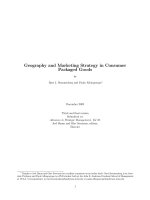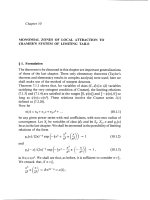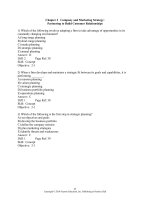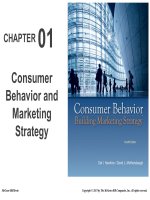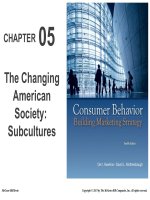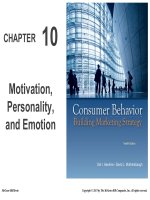Consumer behavior and marketing strategy 12e hawkins motherbaugh chapter 10
Bạn đang xem bản rút gọn của tài liệu. Xem và tải ngay bản đầy đủ của tài liệu tại đây (2.42 MB, 33 trang )
CHAPTER
10
Motivation, Personality,
and Emotion
McGraw-Hill/Irwin
Copyright © 2013 by The McGraw-Hill Companies, Inc. All rights reserved.
PART III: INTERNAL INFLUENCES
10-2
Learning Objectives
L01
L01
L02
L02
L03
L03
L04
L04
L05
L05
L06
L06
Define motivation and summarize the motivation sets put forth by Maslow and McGuire
Articulate motivation’s role in consumer behavior and marketing strategy
Define personality and the various theories of personality
Discuss how brand personality can be used in developing marketing strategies
Define emotions and list the major emotional dimensions
Discuss how emotions can be used in developing marketing strategies
10-3
Consumer Behavior In The News…
Are Front-Line Employees Your Brand?
Do you think front-line employees (e.g., Bank Tellers) affect the perceived brand
personality of a company?
No
Yes
Source: D. Wentzel, “The Effect of Employee Behavior on Brand Personality Impressions and Brand Attitudes, Journal of the Academy of Marketing Science, 2009, pp. 359-374.
10-4
Consumer Behavior In The News…
Are Front-Line Employees Your Brand?
Do you think front-line employees (e.g., Bank Tellers) affect the perceived brand
personality of a company?
No
Yes – if you said yes you are correct!
And the effect gets stronger the more consumers link the employee with the
company.
Source: D. Wentzel, “The Effect of Employee Behavior on Brand Personality Impressions and Brand Attitudes, Journal of the Academy of Marketing Science, 2009, pp. 359-374.
10-5
The Nature of Motivation
Motivation is the reason for behavior.
A motive is a construct representing an unobservable inner force that stimulates and compels a
behavioral response and provides specific direction to that response.
There are numerous theories of motivation, and many of
them offer useful insights for the marketing manager.
10-6
The Nature of Motivation
Two useful motivation theories:
1.
Maslow’s Hierarchy of Needs
•
2.
A macro theory designed to account for most human behavior in general terms.
McGuire’s Psychological Motives
•
A fairly detailed set of motives used to account for specific aspects of consumer behavior.
10-7
The Nature of Motivation
McGuire’s Psychological Motives
1.
1. Cognitive
Cognitive Preservation
Preservation Motives
Motives
Need for Consistency (active, internal)
Need for Consistency (active, internal)
Need for Attribution (active, external)
Need for Attribution (active, external)
Attribution Theory
Attribution Theory
Need to Categorize (passive, internal)
Need to Categorize (passive, internal)
Need for Objectification (passive, external)
Need for Objectification (passive, external)
10-8
The Nature of Motivation
McGuire’s Psychological Motives
2.
2. Cognitive
Cognitive Growth
Growth Motives
Motives
Need for Autonomy (active, internal)
Need for Autonomy (active, internal)
Need for Stimulation (active, external)
Need for Stimulation (active, external)
Teleological Need (passive, internal)
Teleological Need (passive, internal)
Utilitarian Need (passive, external)
Utilitarian Need (passive, external)
10-9
The Nature of Motivation
McGuire’s Psychological Motives
3.
3. Affective
Affective Preservation
Preservation Motives
Motives
Need for Tension Reduction (active, internal)
Need for Tension Reduction (active, internal)
Need for Expression (active, external)
Need for Expression (active, external)
Need for Ego Defense (passive, internal)
Need for Ego Defense (passive, internal)
Need for Reinforcement (passive, external)
Need for Reinforcement (passive, external)
10-10
The Nature of Motivation
McGuire’s Psychological Motives
4.
4. Affective
Affective Growth
Growth Motives
Motives
Need for Assertion (active, internal)
Need for Assertion (active, internal)
Need for Affiliation (active, external)
Need for Affiliation (active, external)
Need for Identification (passive, internal)
Need for Identification (passive, internal)
Need for Modeling (passive, external)
Need for Modeling (passive, external)
10-11
Applications in Consumer Behavior
The Mercedes-Benz ad provides an excellent
example of targeting women high in need for
assertion.
They are competitive achievers, seeking
success, admiration, and dominance.
Important to them are power,
accomplishment, and esteem.
Courtesy Mercedes Benz USA, Inc.
10-12
Motivation Theory and Marketing Strategy
Latent and Manifest Motives in a Purchase Situation
10-13
Motivation Theory and Marketing Strategy
Marketing Strategy Based on Multiple Motives
Involvement is a motivational state caused by consumer perceptions that a product, brand, or
advertisement is relevant or interesting.
Consumer involvement increases attention, analytical processing, information search, and word of mouth.
Ford Fiesta Commercial Encourages Consumer Involvement and is Based on Multiple
Motives
YouTube Spotlight
10-14
Motivation Theory and Marketing Strategy
Marketing Strategies Based on Motivation Conflict
Three types of motivational conflict:
1.
Approach-Approach Motivational Conflict
•
2.
Approach-Avoidance Motivational Conflict
•
3.
A choice between two attractive alternatives
A choice with both positive and negative consequences
Avoidance-Avoidance Motivational Conflict
•
A choice involving only undesirable outcomes
10-15
Motivation Theory and Marketing Strategy
10-16
Motivation Theory and Marketing Strategy
Situational Component Related to Regulatory Focus
Online Travel Shopping
1.
Prevention-Focused Ad
•
2.
Worked best for last-minute shoppers
Promotion-Focused Ad
•
Worked best for shoppers buying for future travel
10-17
Personality
Personality is an individual’s characteristic response
tendencies across similar situations.
While motivations are the energizing and directing force that
makes consumer behavior purposeful and goal directed, the
personality of the consumer guides and directs the behavior
chosen to accomplish goals in different situations.
10-18
Personality
1.
Multitrait Approach
•
The Five-Factor Model is the most commonly used by marketers and identifies five basic traits that are
formed by genetics and early learning.
2.
Single Trait Approach
•
•
•
Consumer Ethnocentrism
Need for Cognition
Consumers’ Need for Uniqueness
10-19
Personality
10-20
Personality
Single-Trait Approach:
1.
Consumer Ethnocentrism
•
Reflects an individual difference in consumers’ propensity to be biased against the purchase of foreign
products.
2.
Need for Cognition (NFC)
•
3.
Reflects an individual difference in consumers’ propensity to engage in and enjoy thinking.
Consumers’ Need for Uniqueness
•
Reflects an individual difference in consumers’ propensity to pursue differentness relative to others
through the acquisition, utilization, and disposition of consumer goods.
10-21
Use of Personality in Marketing Practice
Other times, consumers use
Sometimes consumers choose
products that fit their
personality.
products to bolster an area of
their personality where they feel
weak.
10-22
Use of Personality in Marketing Practice
Brand image is what people think of and feel when they hear or see a brand name.
Brand personality is a set of human characteristics that become associated with a
brand and are a particular type of image that some brands acquire.
10-23
Video Application
The following Video Clip demonstrates how Apple built brand
personality with its “Think Different” integrated marketing campaign!
10-24
10-25
10-25
